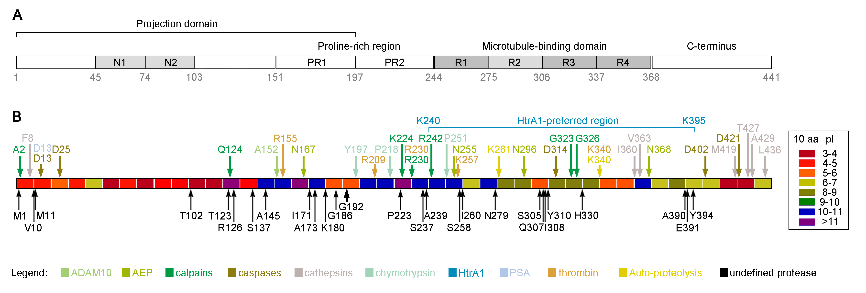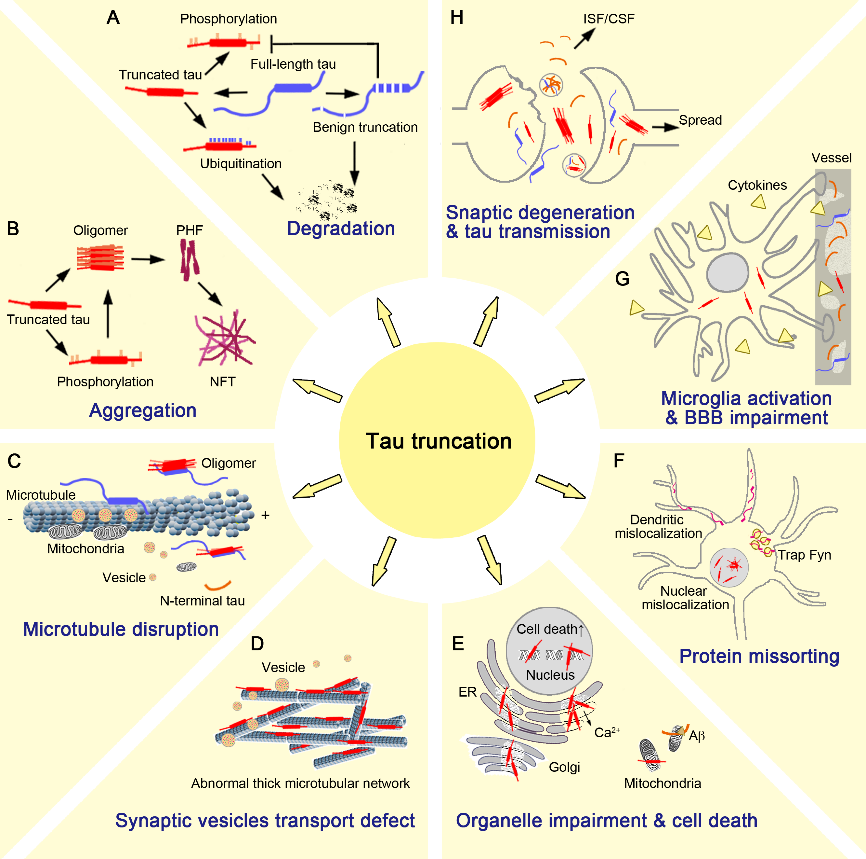NRR:南通大学吴锋团队全面总结tau截断体在阿尔茨海默病发病机制中的作用
撰文:杨星月,储丹丹
阿尔茨海默病是老年人群最常见的痴呆,其症状主要包括早期学习、短期记忆和空间导航障碍,注意力、语言、执行功能和自我照顾能力逐渐丧失以及情绪、思维和行为变化等。阿尔茨海默病典型的神经病理学特征包括细胞外β淀粉样蛋白斑块和细胞内过度磷酸化tau蛋白聚集成的神经纤维缠结。大脑中tau的病理变化先于阿尔茨海默病临床症状出现[1],并与患者认知能力下降直接相关[2]。
天然的tau蛋白为无规则卷曲结构,几乎没有聚集。一旦部分折叠成β片层,即可能引发单体间聚集,逐渐形成可溶性二聚体、低聚物、不溶性成对螺旋丝和神经纤维缠结,呈朊样聚集特性[3]。在阿尔茨海默病大脑中,病理性tau由蓝斑和内嗅皮质部位起源,传播到边缘系统,最终蔓延到新皮质[4]。tau蛋白截断对病理性tau的产生和朊样传播起关键作用,被认为是阿尔茨海默病神经病变的关键驱动力之一。目前,多种针对tau部分片段和表位的阿尔茨海默病治疗策略正在开发。此外,tau截断体还能释放到脑间质液、脑脊液和血液中,可作为阿尔茨海默病的潜在标志物[5]。然而,tau截断体在阿尔茨海默病发病机制中的作用尚缺乏深入而全面的总结。
最近,来自中国南通大学吴锋团队在《中国神经再生研究(英文版)》(Neural Regeneration Research)上发表了题为“Tau truncation in the pathogenesis of Alzheimer’s disease: a narrative review”的综述。该综述总结了tau的60多个截断位点和相应截断片段,探索了特定截断体在生理和阿尔茨海默病病理状态下的作用,并归纳了tau片段的靶向策略在阿尔茨海默病诊断和治疗中的最新应用。
人tau蛋白是一种高度水溶性和内在无序的蛋白质,由染色体17q21.31上的MAPT基因编码。人类中枢神经系统中最长的tau亚型由441个氨基酸(amino acid, a.a.)组成,分子量为46kDa;包含3个结构域(图1A):(i)从微管表面突出的N末端酸性投射结构域,(ii)与含SH3结构域的蛋白质相互作用所需的富含脯氨酸的碱性区,(iii)介导微管组装和自聚集的微管结合重复序列,以及(iv)C末端。其主要生理功能是结合并稳定微管、促进微管的组装。

图1tau蛋白的结构域(A)和截断位点(B)(图源:Chu et al., Neural Regen Res, 2024)
为探索tau在生理和阿尔茨海默病病理状态下的截断及其作用,吴锋等对PubMed数据库1988至2022年收集了有关tau截断体和阿尔茨海默病的文献进行检索。结果发现,tau截断体最早于1988年,从阿尔茨海默病脑中成对螺旋丝的抗蛋白酶核心区域中分离出来[6]。迄今为止,tau蛋白的所有4个结构域中共发现了tau的60多个蛋白酶水解切割位点[5](图1B),并在阿尔茨海默病大脑中造成30多种不同长度的截断体[7]。tau截断位点中一半以上已确定了相应的蛋白酶,包括去整合素和金属肽酶结构域10蛋白(a disintegrin and metallopeptidase domain 10)、天冬酰胺内肽酶(asparagine endopeptidase)、钙蛋白酶(calpains)、半胱天冬酶(caspases)、组织蛋白酶(cathepsins)、糜蛋白酶(chymotrypsin)、人高温需求丝氨酸蛋白酶A1(human high-temperature requirement serine protease A1)、嘌呤霉素敏感氨基肽酶(puromycin-sensitive aminopeptidase)、凝血酶和基质金属蛋白酶(thrombin and matrix-metalloproteinases)等。此外,tau蛋白在K281和K340处可发生自乙酰化,也能引起K281-L282和K340-S341位点处发生自水解[8]。一般来说,tau截断体的序列决定了其特征和病理意义。
研究通过识别tau不同表位的抗体检测大脑中不同tau组分的截断情况。在健康的人脑中,大约3/4的可溶性tau为全长tau,而其余的是C末端截断体[9]。然而,在阿尔茨海默病患者大脑中,神经纤维缠结中tau则存在明显的N末端丢失[10]。吴锋等的合作课题组既往一系列研究发现,大脑中热稳定的单体tau几乎不存在截断现象[11],阿尔茨海默病患者大脑中具有朊样毒性的tau高分子量寡聚物主要是N末端截断造成的[12],而C末端尽管被过度磷酸化[13],却基本保持完整[12]。此外,在18-22月龄的老龄野生型和阿尔茨海默病模型小鼠大脑中,tau截断则非常有限[14],这显示了模型动物和人类之间存在差异。
在生理条件下,tau的酸性N和C末端常折叠于碱性的微管结合重复序列(图1B),形成回形针状构象,以防止蛋白质自聚集[15]。良性位点截断有利于tau蛋白水解,从而促进其正常降解(图2A)[16]。而在阿尔茨海默病病理条件下,N和C末端的截断暴露出微管结合区域,从而促进tau微管结合区域的聚集和纤维化[17]。吴锋等探讨了阿尔茨海默病脑中发现的tau截断位点,如N368、E391、D421等在体内和体外对tau聚集的影响。此外,吴锋等合作课题组也构建了一系列tau截断体,分别可切除tau蛋白的N端50、150或230个氨基酸和/或C端20或50个氨基酸,并分析了这些截断体被诱导聚集的能力。结果发现,在全长tau蛋白和各种截断体中,tau151-391表现出最强的病理特性,即最强的过度磷酸化、最易发生自聚集、最容易与阿尔茨海默病大脑中朊样毒性寡聚体tau结合并被其诱导聚集[18]。
除促进聚集外,tau截断还能调节自身的翻译后修饰(如过度磷酸化和泛素化)、破坏微管稳定性、影响蛋白质分选、造成突触囊泡运输障碍进而导致突触功能受损、单独或与β淀粉样蛋白共同诱导线粒体功能异常、破坏内质网和高尔基体、调节细胞信号、诱发细胞死亡、刺激小胶质细胞激活、损伤血脑屏障、影响tau单体和聚集体的跨突触传递等(图2)。

图2tau截断在生理和阿尔茨海默病病理条件下的作用(图源:Chu et al., Neural Regen Res, 2024)
截断的tau片段不仅可沉积在大脑中,还能够释放到大脑间质液[19]和脑脊液[20]中,甚至穿越血脑屏障进入血清[21]。其中一些特定的N端片段,在阿尔茨海默病患者的脑脊液和血清中显著增多,因而可作为阿尔茨海默病诊断的新的潜在标志物[22]。#br#
最后,吴锋等对美国食品药品管理局批准临床试验的靶向tau的免疫疗法进行了汇总(表1)。值得注意的是,针对tau的被动免疫疗法中,有4项的临床试验针对tau的N末端表位。其中3项临床试验已停止(BIIB076、Gosuranemab和Tilavonemab),另一项(Semorinemab)对阿尔茨海默病病程进展的抑制作用不佳[23],推测这些策略所靶向的tau N末端肽段在最具朊样毒性的tau寡聚物中已被截除[12],故不能有效抑制tau寡聚物诱导的病理朊样传播。因此,选择对tau聚集至关重要的微管结合重复序列,而非N末端表位作为抗tau疗法的靶点,可能对阿尔茨海默病治疗具有更积极的意义。
总之,tau的正常水解截断对其降解和清除至关重要,是维持微管动态所必需的。而tau截断的失调可能导致(i)tau聚集或翻译后修饰改变,从而降低其调节微管动态的能力;(ii)直接或间接破坏细胞的功能结构,包括突触、线粒体、内质网、高尔基体、细胞核等;(iii)导致神经元死亡或神经胶质激活的信号通路变化;(iv)更多地渗漏到大脑间质液、脑脊液甚至血液中。尤其是具有朊样活性的tau截断体的释放可能促进tau病理在大脑中传播。因此,tau蛋白的异常截断通过对神经元分子、细胞结构和大脑稳态产生广泛损伤,深刻影响阿尔茨海默病病理的发生和进展。在临床应用中,N末端磷酸化的tau片段可作为阿尔茨海默病早期诊断的前瞻性生物标志物,而tau中部的微管结合重复序列则是目前抗体疗法的热门靶点。
当然,需要指出的是,tau的异常截断不仅发生在阿尔茨海默病中,在许多其他的神经退行性疾病(如皮质基底部变性、额颞叶痴呆、皮克氏病和进行性核上性麻痹)中也有发现[37]。tau截断体如何在不同类型的神经退行性疾病中发挥致病作用,对于理解包括阿尔茨海默病在内的神经退行性疾病的发病机制、探索相应的靶向治疗方案具有重要意义。
原文链接:https://doi.org/10.4103/1673-5374.385853
参考文献
[1] Braak H, Zetterberg H, Del Tredici K, et al. Intraneuronal tau aggregation precedes diffuse plaque deposition, but amyloid-β changes occur before increases of tau in cerebrospinal fluid. Acta Neuropathol. 2013;126(5):631-641.
[2] Arriagada PV, Marzloff K, Hyman BT. Distribution of Alzheimer-type pathologic changes in nondemented elderly individuals matches the pattern in Alzheimer's disease. Neurology. 1992;42(9):1681-1688.
[3] Chu D, Liu F. Pathological changes of tau related to Alzheimer's disease. ACS Chem Neurosci. 2019;10(2):931-944.
[4] Braak H, Del Tredici K. The pathological process underlying Alzheimer's disease in individuals under thirty. Acta Neuropathol. 2011;121(2):171-181.
[5] Quinn JP, Corbett NJ, Kellett KaB, et al. Tau proteolysis in the pathogenesis of tauopathies: neurotoxic fragments and novel biomarkers. J Alzheimers Dis. 2018;63(1):13-33.
[6] Wischik CM, Novak M, Thøgersen HC, et al. Isolation of a fragment of tau derived from the core of the paired helical filament of Alzheimer disease. Proc Natl Acad Sci U S A. 1988;85(12):4506-4510.
[7] Xia Y, Lloyd GM, Giasson BI. Targeted proteolytic products of τ and α-synuclein in neurodegeneration. Essays Biochem. 2021;65(7):905-912.
[8] Cohen TJ, Constance BH, Hwang AW, et al. Intrinsic tau acetylation is coupled to auto-proteolytic tau fragmentation. PLoS One. 2016;11(7):e0158470.
[9] Sato C, Barthélemy NR, Mawuenyega KG, et al. Tau kinetics in neurons and the human central nervous system. Neuron. 2018;98(4):861-864.
[10] García-Sierra F, Ghoshal N, Quinn B, et al. Conformational changes and truncation of tau protein during tangle evolution in Alzheimer's disease. J Alzheimers Dis. 2003;5(2):65-77.
[11] Li L, Shi R, Gu J, et al. Alzheimer's disease brain contains tau fractions with differential prion-like activities. Acta Neuropathol Commun. 2021;9(1):28.
[12] Zhou Y, Shi J, Chu D, et al. Relevance of phosphorylation and truncation of tau to the etiopathogenesis of Alzheimer's disease. Front Aging Neurosci. 2018;10:27.
[13] Wu R, Li L, Shi R, et al. Dephosphorylation passivates the seeding activity of oligomeric tau derived from Alzheimer's brain. Front Mol Neurosci. 2021;14:631833.
[14] Li L, Jiang Y, Hu W, et al. Pathological alterations of tau in Alzheimer's disease and 3xTg-AD mouse brains. Mol Neurobiol. 2019;56(9):6168-6183.
[15] Mandelkow E, Von Bergen M, Biernat J, et al. Structural principles of tau and the paired helical filaments of Alzheimer's disease. Brain Pathol. 2007;17(1):83-90.
[16] Poepsel S, Sprengel A, Sacca B, et al. Determinants of amyloid fibril degradation by the PDZ protease HTRA1. Nat Chem Biol. 2015;11(11):862-869.
[17] Novak P, Cehlar O, Skrabana R, et al. Tau conformation as a target for disease-modifying therapy: the role of truncation. J Alzheimers Dis. 2018;64(s1):S535-S546.
[18] Gu J, Xu W, Jin N, et al. Truncation of Tau selectively facilitates its pathological activities. J Biol Chem. 2020;295(40):13812-13828.
[19] Barini E, Plotzky G, Mordashova Y, et al. Tau in the brain interstitial fluid is fragmented and seeding-competent. Neurobiol Aging. 2022;109:64-77.
[20] Blennow K, Chen C, Cicognola C, et al. Cerebrospinal fluid tau fragment correlates with tau PET: a candidate biomarker for tangle pathology. Brain. 2020;143(2):650-660.
[21] Banks WA, Kovac A, Majerova P, et al. Tau proteins cross the blood-brain barrier. J Alzheimers Dis. 2017;55(1):411-419.
[22] Hawksworth J, Fernández E, Gevaert K. A new generation of AD biomarkers: 2019 to 2021. Ageing Res Rev. 2022;79:101654.
[23] Slomski A. Anti-tau antibody semorinemab fails to slow Alzheimer disease. JAMA. 2022;328(5):415.
[24] Albert M, Mairet-Coello G, Danis C, et al. Prevention of tau seeding and propagation by immunotherapy with a central tau epitope antibody. Brain. 2019;142(6):1736-1750.
[25] Roberts M, Sevastou I, Imaizumi Y, et al. Pre-clinical characterisation of E2814, a high-affinity antibody targeting the microtubule-binding repeat domain of tau for passive immunotherapy in Alzheimer's disease. Acta Neuropathol Commun. 2020;8(1):13.
[26] Bijttebier S, Theunis C, Jahouh F, et al. Development of immunoprecipitation - two-dimensional liquid chromatography - mass spectrometry methodology as biomarker read-out to quantify phosphorylated tau in cerebrospinal fluid from Alzheimer disease patients. J Chromatogr A. 2021;1651:462299.
[27] Rosenqvist N, Asuni AA, Andersson CR, et al. Highly specific and selective anti-pS396-tau antibody C10.2 targets seeding-competent tau. Alzheimers Dement (N Y). 2018;4:521-534.
[28] Kondo A, Shahpasand K, Mannix R, et al. Antibody against early driver of neurodegeneration cis P-tau blocks brain injury and tauopathy. Nature. 2015;523(7561):431-436.
[29] Teng E, Manser PT, Pickthorn K, et al. Safety and efficacy of semorinemab in individuals with prodromal to mild Alzheimer disease: a randomized clinical trial. JAMA Neurol. 2022;79(8):758-767.
[30] Nobuhara CK, Devos SL, Commins C, et al. Tau antibody targeting pathological species blocks neuronal uptake and interneuron propagation of tau in vitro. Am J Pathol. 2017;187(6):1399-1412.
[31] Qureshi IA, Tirucherai G, Ahlijanian MK, et al. A randomized, single ascending dose study of intravenous BIIB092 in healthy participants. Alzheimers Dement (N Y). 2018;4:746-755.
[32] Collin L, Bohrmann B, Göpfert U, et al. Neuronal uptake of tau/pS422 antibody and reduced progression of tau pathology in a mouse model of Alzheimer's disease. Brain. 2014;137(Pt 10):2834-2846.
[33] Yanamandra K, Kfoury N, Jiang H, et al. Anti-tau antibodies that block tau aggregate seeding in vitro markedly decrease pathology and improve cognition in vivo. Neuron. 2013;80(2):402-414.
[34] Jicha GA, Bowser R, Kazam IG, et al. Alz-50 and MC-1, a new monoclonal antibody raised to paired helical filaments, recognize conformational epitopes on recombinant tau. J Neurosci Res. 1997;48(2):128-132.
[35] Novak P, Zilka N, Zilkova M, et al. AADvac1, an active immunotherapy for Alzheimer's disease and non Alzheimer tauopathies: an overview of preclinical and clinical development. J Prev Alzheimers Dis. 2019;6(1):63-69.
[36] Theunis C, Crespo-Biel N, Gafner V, et al. Efficacy and safety of a liposome-based vaccine against protein Tau, assessed in tau.P301L mice that model tauopathy. PLoS One. 2013;8(8):e72301.
[37] Boyarko B, Hook V. Human tau isoforms and proteolysis for production of toxic tau fragments in neurodegeneration. Front Neurosci. 2021;15:702788.

